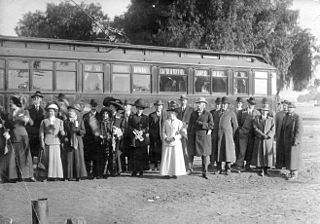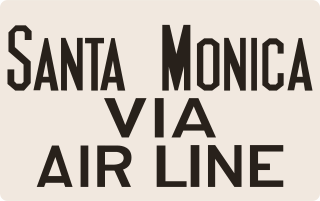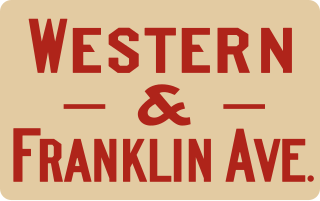
The Pacific Electric Railway Company, nicknamed the Red Cars, was a privately owned mass transit system in Southern California consisting of electrically powered streetcars, interurban cars, and buses and was the largest electric railway system in the world in the 1920s. Organized around the city centers of Los Angeles and San Bernardino, it connected cities in Los Angeles County, Orange County, San Bernardino County and Riverside County.

Laurel Canyon is a mountainous neighborhood in the Hollywood Hills region of the Santa Monica Mountains, within the Hollywood Hills West district of Los Angeles, California. The main thoroughfare of Laurel Canyon Boulevard connects the neighborhood with the more urbanized parts of Los Angeles to the north and south, between Ventura Boulevard and Hollywood Boulevard.

The Hollywood Subway, as it is most commonly known, officially the Belmont Tunnel, was a subway tunnel used by the interurban streetcars of the Pacific Electric Railway. It ran from its northwest entrance in today's Westlake district to the Subway Terminal, in the Historic Core, the business and commercial center of the city from around the 1910s through the 1950s. The Subway Terminal was one of the Pacific Electric Railway’s two main hubs, the other being 6th and Main. Streetcars of numerous Pacific Electric lines proceeded from the San Fernando Valley, Glendale, Santa Monica and Hollywood into the tunnel in Westlake and traveled southeast under Crown and Bunker Hill towards the Subway Terminal.

South Pasadena Local was a local streetcar line operated by the Pacific Electric Railway between Downtown Los Angeles and South Pasadena, California by way of the Arroyo Seco Route. This was one of four lines that connected the two cities.

Glendale–Burbank is a defunct Pacific Electric railway line that was operational from 1902 to 1955 in Southern California, running from Downtown Los Angeles to Burbank via Glendale. Short lines terminated Downtown and in North Glendale, including the popular Edendale Local.

The San Fernando Line was a part of the Pacific Electric Railway system in Los Angeles County, California. It was designed to increase the reach of public transportation from the Downtown Los Angeles and Hollywood into the San Fernando Valley, to support land speculation and development expanding Los Angeles.

The Santa Monica Air Line was an interurban railroad operated by the Pacific Electric between Santa Monica and downtown Los Angeles. It operated between 1909 and 1953. Most of the route is now used by the E Line.
The Westgate Line was a suburban route operated by the Pacific Electric Railway from 1911 to 1940. This line was one of four lines connecting Downtown Los Angeles and Santa Monica that did not run through Hollywood. The line is notable for taking a circuitous route towards its end, along San Vicente Boulevard, mainly because it was built to encourage construction of new homes near Pacific Palisades.
The Sawtelle Line was an interurban railway route operated by the Pacific Electric Railway that ran between Downtown Los Angeles and Santa Monica, California.
The Sherman Line was a suburban route of the Pacific Electric Railway, originally built in 1896 as part of the Pasadena and Pacific. Pasadena and Pacific became part of the Los Angeles Pacific Railroad. The line ran between Downtown Los Angeles and the suburb of Sherman. The line was named after Moses Sherman, who built the line and the Sherman street car yard on the line in West LA. The large 5.56-acre (2.25 ha) rail facility was on Santa Monica Boulevard just west of La Cienega Boulevard. The yard had a steam power house, a car barn and a shop building. Pacific Electric moved the yard works to 7th & Central in LA. In the 1930s buses started to run from the depot there also. The line was discontinued on September 25, 1954. In 1974 all the rail buildings were demolished for development.

The Owensmouth Line was a Pacific Electric interurban service that connected the San Fernando Valley to Downtown Los Angeles. The route was largely developed as the result of real estate speculation.
5 or the 5 Car was a streetcar line operated by the Los Angeles Railway, later named the Los Angeles Transit Lines, and by the Los Angeles Metropolitan Transit Authority. From 1920 to 1932, this route was known as the E Car. This was changed as part of a method to distinguish routes that lacked loops at their termini. Consequently, the 5 Car was unique during the LAMTA era in that it did not use PCC streetcars. It used buses from 1955 to 1964, transferring from LATL in 1958, then splitting the line in two in 1961, until all lines were turned over to SCRTD in August 1964.

The Venice Short Line was a Pacific Electric interurban railway line in Los Angeles which traveled from downtown Los Angeles to Venice, Ocean Park, and Santa Monica via Venice Boulevard.

The Los Angeles Pacific Railroad (1896−1911) (LAP) was an electric public transit and freight railway system in Los Angeles County, California. At its peak it had 230 miles (370 km) of track extending from Downtown Los Angeles to the Westside, Santa Monica, and the South Bay towns along Santa Monica Bay.

The Long Wharf in Santa Monica, also known as Port Los Angeles or the Mile Long Pier, was an extensive pier wharf constructed by the Southern Pacific Railroad Company in Santa Monica Bay from 1892–94. When it opened in 1894, it was the longest wharf in the world, measuring approximately 4,700 feet. It served as a cargo and passenger port until 1913, and in 1919 removal of the wharf started. The wharf, the 1000 foot tip of the pier, was removed by 1920. The remaining 3,600 feet of pier was used as a run down fishing pier until 1933, when the remainder of the pier was removed. One of the major imports to the wharf was lumber from Northern ports, to help in the construction boom in Southern California. Southern Pacific Railroad and the street cars of the Los Angeles Pacific Railroad served the wharf. Los Angeles Pacific Railroad ran passenger trams to the wharf and from midnight to sunrise ran cargo cars.

Owensmouth, California, was a town founded in 1912 in the western part of the San Fernando Valley. Owensmouth joined the city of Los Angeles in 1917, and was renamed Canoga Park on March 1, 1931. Owensmouth was named for the 1913 Owens River aqueduct's terminus in current Canoga Park. The town was started by the Los Angeles Suburban Homes Company as part of an extraordinary real estate development in Southern California. Los Angeles Suburban Homes Company was owned by a syndicate of rich Los Angeles investors, developers, and speculators: including Harrison Gray Otis, Harry Chandler, Moses Sherman, Hobart Johnstone Whitley, and others. On April 2, 1915, H. J. Whitley purchased the Suburban Home Company so that he would have complete control for finishing the development. It anticipated possible connections to but was planned independent of the soon to be completed (1913) Los Angeles Aqueduct from the Owens River watershed to the City of Los Angeles through the San Fernando Valley in Los Angeles County.The newly built Sherman Way double drive and the Pacific Electric street cars, opened on December 7, 1912, gave new access to the town and to the other new towns in the valley Van Nuys (1911) and Marion ; At the time the new road and streetcar seemed like route to an open agricultural fields at the end of the line — but was a necessity to promote development. Sherman Way was a paved boulevard with lush landscaping and no speed limit where one might get up to 35 mph, there was a separate dirt road for farm wagons/equipment, and telegraph lines.

Cable car street railways first began operating in Los Angeles in 1885 and lasted until 1902, when the lines were electrified and electric streetcars were introduced largely following the cable car routes. There were roughly 25 miles (40 km) of routes, connecting 1st and Main in what was then the Los Angeles Central Business District as far as the communities known today as Lincoln Heights, Echo Park/Filipinotown, and the Pico-Union district.

The Western and Franklin Avenue Line was a Pacific Electric streetcar line which traveled from Los Angeles to Hollywood. It operated from 11th & Hill Streets via Hill, Sunset, Santa Monica Boulevard, Western Avenue, Franklin Avenue, Argyle Avenue, Yucca Street, and Vine Street to end at Hollywood and Vine Boulevards. It operated from 1908 to 1940. The Brush Canyon Line branched from this line at Bronson.
The Echo Park Avenue Line was a Pacific Electric streetcar line in Los Angeles which traveled from 11th and Hill Streets in downtown Los Angeles along the Hollywood Line to Sunset Boulevard where it turned right and proceeded north along Echo Park Avenue to terminate at Cerro Gordo Street.

The Riverside–Arlington Line is a former Pacific Electric interurban railway line in the Inland Empire. The route provided suburban service between San Bernardino and Arlington with a later extension to Corona. It operated between 1893 and 1943.















